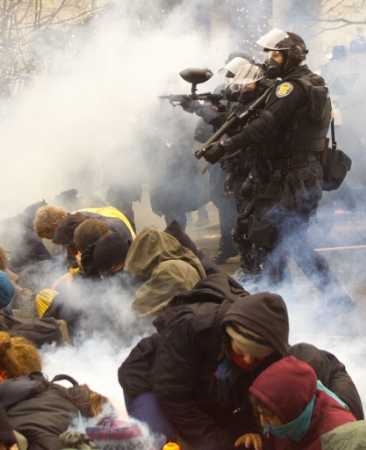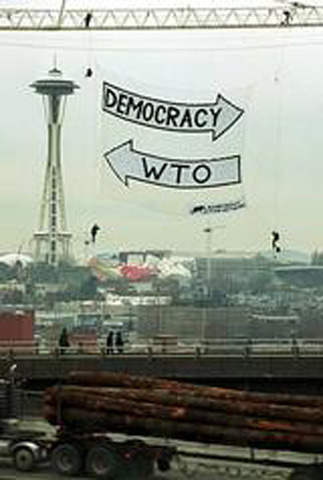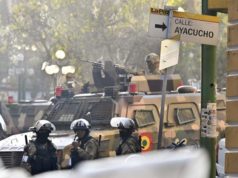The 30th November of this year will mark 10 years since the protests at the WTO summit in Seattle. The so-called direct action movement in Britain had a significant role in the cycle of protests which found its high point in Seattle. Here we tell its story. By Leo Vinicius

In the late 1990s large street demonstrations and attempted blockades of summits of the World Trade Organisation, World Bank, International Monetary Fund, G8, and other organisations managing global capital, won significant TV news coverage and ensured that these meetings would have to be protected by enormous police contingents and removed to remote locations. In a general sense we saw the contours of a new movement opposed to the management organisations of so-called ‘globalisation’. The blockade of the first day of the WTO ministers’ meeting on 30th November 1999 in Seattle was the moment when this movement attained worldwide visibility, in the mainstream media and principally on TV, coming to be known in these same media as ‘anti-globalisation’. In truth it was a ‘movement of movements’ or further still a confluence of movements. The point of identification bringing together was a common recognition of the systemic organisations to which they were opposed (although for some of them this system appeared as ‘capitalism’ for others ‘neo-liberalism’ and so on).
But if it is now ten years since the Seattle protests, on 18th June this year it was the tenth anniversary of protests which made the headlines in the British papers for months. This was J18, the Global Day of Action Against Capitalism, much like 30th November, taking place during the G8 meeting in Colonia. In London the demonstrations represented for sure an expression of the development of Britain’s so-called direct action movement. This direct action movement, whose anti-roads protests of the 1990s were a focus for much effort and many victories, was an example of one of the most significant social movements of recent times, given its decidedly anti-capitalist objectives, taking place in one of the richest and most stable societies, with various social groups involved and a real material base: although the problems it faced were linked to these characteristics.
***

The global ‘anti-globalisation’ resistance movement was the creation of these English activists. London Reclaim the Streets was the most significant impulse for the Days of Global Action in Europe in 1998 and 1999, and probably also on a worldwide level. The English were the first to take on this idea, which later spread everywhere, of a global movement. At the 1997 annual meeting of Britain’s Earth First! it was already clear that the majority of participants saw the British radical ecology movement (and EF! in particular) as a ‘network of revolutionaries, part of a global libertarian-ecologist movement of movements’ (http://www.eco-action.org/dod/no10/empire-history.htm).
Such sensibilities reflected the difficulty for English activists in being able to see the possibility of change in their abundant society where there was a reduced level of poverty; and also conscious that their lifestyle was sustained by the exploitation of peoples overseas. English activists’ eyes were always, therefore, turned to the movements of the global South, the so-called Third World, lending them a certain determination to look at and help link together diverse struggles and geographically distant movements into one global movement. At the same time as this determination to see what was global in each local movement, there grew a third-worldist tendency, within whose framework the most important struggles were always those of others. The emphasis on solidarity with the movements of the global South was not only an expression of understanding being part of a global movement, but equally the idea that the real struggle would always be taken on by others.
Before continuing let us briefly explain what Reclaim the Streets (RTS) and Earth First! are. The names denote more than groups, collectives or movements, but more like banners. Just the same as Armed Proletarians for Communism, in which Cesare Battisti participated – the only political refugee in the world who is kept prisoner in the same country which granted him refuge – RTS and EF! are names which serve for the actions of various collectives and independent cells, which can be formed by whoever identifies with that banner, with their own principles and means of action. EF!, as its participants say, is a sort of “flag of convenience” rather than an organisation in the proper sense of the word. We can similarly understand RTS as representing a means of action, taking over the roads, and more generally actions breaking down the division between party and protest. Earth First! was not in reality a group, movement or entity, but a name bringing together people with common objectives, principles and tactics, namely to defend nature and the environment. In 2001 RTS in London defined itself as “a network for direct action which initially emerged in London in the early 1990s and which now comprises of autonomous groups across the world. RTS makes use of creative actions in a struggle for positive, socially just and ecological alternatives to capitalism and the current hierarchical social order”.
Returning to the early part of the decade, with the emergence of Earth First! in England, we can begin to trace the path which brings us to J18 – the Day of Global Action of June 18th 1999 which had great impact in England but also anticipated and acted as a stimulus for the events in Seattle a few months later.
Earth First! was created in the USA in 1980 by five friends who were long-time ecologists discontent with the institutionalisation and inefficacy of the existing ecologist organisations and their practice. EF! took direct action as its practice and biocentrism as its theory. EF! groups spread across the United States, forming an informal network of autonomous groups who took direct action, occupying, sabotaging, breaking machines, subverting advertising, etc.
EF! appeared in England in 1991 in a context similar to what had existed in the USA, as an alternative to the bureaucratisation and institutionalisation of ecologist organisations. But in the case of Europe it would be created by a new generation of activists. The first British EF! group was set up by two students, Jake Bowers and Jason Torrance, in East Sussex. They had participated in other environmentalist groups and become disillusioned with them. The group’s first action was the blockade of the nuclear power station at Dungeness in Kent, which involved around 50 people from local pacifist and anti-nuclear circles.
The British version was differentiated from its American equivalent by its greater combination of social concerns with environmental ones. According to its British founders, this was necessary for EF! to take off in the UK. Sustained by a generation of activists who were in the majority students and people on the dole, disillusioned with the practice and inefficacy of the existing environmentalist organisations, EF! groups were established in places like London, Liverpool, Brighton, Oxford, Manchester, Norwich and Glastonbury.
Reclaim the Streets was formed in London in late 1991, at the same time as the birth of the anti-roads movement opposing the ‘Roads for Prosperity’ project, launched by the British government as the greatest road-building programme since the Roman Empire. A small group of people linked to the EF! network decided to take direct action against the rise of the care. In their own words, they were acting “for walking, cycling and free or cheap public transport, and against cars, roads and the system supporting them”. RTS’s actions in this first phase – until 1993 – already displayed some of the sense of humour and surprise which would characterise it in the second half of the decade. Small street blockades, subvertising car ads, painting cycle paths on the streets of London and ‘happenings’ at car exhibitions were among the actions undertaken by RTS in this period.
 The first British EF! meeting took place in Brighton in April 1992, with 60 activists participating. There were already 7 EF! groups listed in the EF! Action Update bulletin. The first months of 1992 would define the activities which took place throughout the decade: a national cycle of actions, anti-roads campaigns, occupations of offices, sabotage and street blockades.
The first British EF! meeting took place in Brighton in April 1992, with 60 activists participating. There were already 7 EF! groups listed in the EF! Action Update bulletin. The first months of 1992 would define the activities which took place throughout the decade: a national cycle of actions, anti-roads campaigns, occupations of offices, sabotage and street blockades.
EF! found its niche with the campaign at Twyford Down, part of Hampshire known for its natural beauty and its remains from pre-historic times and ancient civilisations, such as its ancient tracks, formed over thousands of years and known as Dongas. The resistance at Twyford Down marked the beginning of the anti-roads movement in the UK, initiated by a group of people calling themselves the Dongas Tribe. This group was fromed by people from existing counter-cultures, such as the ‘travellers’. They had their origins in the free music festivals of the 1970s. They picked up this name thanks to their nomadic lifestyle, travelling in vans, pick-ups and trailers, often in convoy, from one festival or event to another and setting up camp. The movement started being repressed by the British government in the 1980s with its attempts to stop campsites. One infamous episode was the Battle of the Beanfield in 1985, the greatest mass arrest in English history.
In the 1990s many travellers migrated to other European countries, but in spite of reduced numbers compared to previous decades, this counterculture still exists in England. As EF! activists have described, Twyford Down was a struggle for land and to protect a threatened area where it was possible to feel, and connect with, what was being fought for, and therefore become part of the area. That was why they could engage in a prolonged physical resistance which would last for several months. They built homes in the trees and adopted a lifestyle at harmony with their surroundings, creating an accessible and permanent point of reference for activists and ecologists from across the country.
Resistance at Twyford Down
At Twyford Down there also developed a combination of features which, for EF! activists, brought ecologist direct action in the UK to the level of a powerful cycle of struggle, with large numbers involved and numerous successes. This involved the combination and exchange of the attitudes of the (mainly rural) travellers and the (mainly urban) EF! individual activists and animal liberation groups. The former brought their knowledge of living in fields and areas being protected against road building; the latter brought to the table their means of action (sabotage of machinery etc.). As the resistance at Twyford Down waned, anti-roads actions spread across the UK. And in spite of the road having been built at Twyford Down, after this resistance, government reports went on to focus on the level of opposition from communities and ecologist groups to road building projects. By late 1993 there were already 45 EF! groups in the UK, and many others catalysed by EF!’s direct actions but who did not operate under their banner.
In this period various networks came together like Alarm UK, formed by anti-roads campaigns and EF! itself, as well as nomadic activists who travelled between areas of resistance to road-building across the country.
[Continued in Part II]
References
– Do or Die magazine, published by the direct action movement: http://www.eco-action.org/dod ;
– The blog Days of Dissent, written by a Brazilian activist radicalised in England: http://diasdedissenso.blogspot.com ;
– The article by Grey Green, Jake Bowers and Jason Torrance, published in the Guardian of May 2nd 2001;
– A 1991 Reclaim The Streets pamphlet
– Adams, D.; Rootes, C.; Seel, B. The Old, the New and the Old New: British environmental organizations from conservationism to radical ecologism. A paper presented in the workshop “Environmental Organisations in Comparative Perspective”, ECPR Joint Sessions, Copenhagen, 14–19 April 2000.
Translated by The Commune. Original at http://passapalavra.info/?p=11022.






